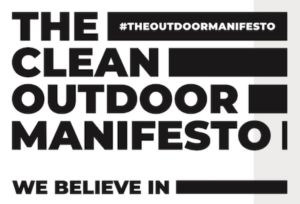The outdoor industry, in reference to those businesses that are connected to outdoor leisure activities, is bringing an increasingly urbanised global population to step outside of cities and enjoy the outdoors. Ever more people are trekking, climbing, cycling and running, which leads them to buy outdoor industry gear. In fact, in 2018 overall gross spending and employment grew faster in outdoor recreation than in the economy at large. A blossoming business.
Most of the activities that the outdoor industry caters to take place on public or protected lands and waters. In fact, protected areas and public lands such as national parks have been experiencing record high numbers of visitors. Take for example the record breaking 331 million visitors to US national parks in 2017. At the same time, the market for outdoor products in 2018 reached 5.8 billion euros in turnover in Europe, and $887 billion in annual domestic consumer spending (whilst also supporting 7.6 million jobs) in the USA.

Whilst outdoor sports are generating large profits for businesses it is increasingly clear that these same companies are not always contributing their fair share towards maintaining natural environments. Furthermore, people involved in outdoor recreation are not necessarily aware of the environmental problems that surround them. A classical example is the often cited discovery that PFCs contained in outdoor apparel waterproofing are washing off rain-jackets and into the biomes of remote areas. Another could be the Guardian’s study on 8 US national parks, revealing that a huge increase in visitors is bringing lasting damage to these popular sites.
Consuming or conserving our natural capital
The problematic relationship between outdoor recreation and environmentalism is not a new topic of discussion. As early as the 1970s two sociologists from Washington State University, Riley Dunlap and Robert Heffernan, sought to uncover the true relationship between outdoor recreation and the flourishing environmental movement of those years, reaching the conclusion that there was no direct correlation.
Similarly, in the Journal of Experiential Education, the debate has continued to this day. Studies indicate that: “Whether a person recreates in the outdoors does not alone predict his or her environmental attitudes.” Simply spending time in the mountains, hills, lakes or rivers doesn’t necessarily translate into awareness and commitment to the environment through direct experience. Furthermore, although the outdoor recreation industry is willing to take a public stance on wild places, there is also widespread reluctance to back up these pledges with financial commitments on any terms other than their own.

This has led to conservation contributions from the outdoor industry that focus on areas known for awe-inspiring scenery; often at the expense of biodiversity-rich lowlands. Why? Because environmentalism has to be marketable! A telling example in the USA has been the lack of support for the highly biodiverse but less visually appealing Cascade-Siskiyou National Monument; versus widespread industry support for the iconic outdoor sports hub Bears Ears National Monument, both of which have been subject to reduction threats by the Trump administration.
A chance to educate consumers
 However, enjoyment of the outdoors can go hand in hand with increased awareness of its intrinsic value. It can also help raise awareness and educate consumers on the current climate crisis through direct experience and attachment to places.
However, enjoyment of the outdoors can go hand in hand with increased awareness of its intrinsic value. It can also help raise awareness and educate consumers on the current climate crisis through direct experience and attachment to places.
Grassroots activism is proving influential in this regard. The Clean Outdoor Manifesto is a non-profit organisation that has created a political manifesto that unites people who engage in outdoor recreational activities under the banner of doing so in a clean and environmentally conscious way. Its mission statement outlines a set of guidelines that dictate the foundations of a balanced relationship between outdoor recreation and the environment, and emphasises the “usefulness of outdoor practices as a way of raising awareness on environmental issues.”
Whilst recreation alone may be a poor way to instil environmental ethics, it’s a good place to start as it brings people to form an attachment to the land that surrounds them and hence gain an interest in its protection and conservation.
Businesses can make a difference
However, it isn’t just about consumers and activism. Another important factor involves the outdoor industry taking an active part in educating people and regulating their own impacts.
A well-known virtuous example is Patagonia, whose very mission statement reads: “Build the best product, cause no unnecessary harm, use business to inspire and implement solutions to the environmental crisis.” In fact, the California based company has long been involved in touting the need for environmental conservation and producing consumer goods that are less harmful for the environment whilst setting an industry standard. Their activism also focuses on spreading the word and educating consumers with efforts such as the creation of a grassroots environmental action network that connects committed individuals to organizations working on environmental issues.
What is certain is that manufacturers and consumers are increasingly concerned with the ecological and social cost of the products they purchase, whether this be for virtuous or profit driven motives. This has led to a spread of labels and certifications that indicate the environmental credentials of any given product.
The label “bluesign® product” is possibly the most recognised within the textile industry, and is particularly widespread in sportswear brands. This particular label is concerned with all of a given product’s effects on people, the environment, and consumption of resources so as to reduce ecological footprint along the entire supply chain. Providing valuable information for consumers and forcing industry players to adhere to certain standards.
Labels and certificates are an important step towards ensuring that the products we use to enjoy the outdoors are regulated and that companies are held accountable for their environmental footprints. At the same time they also become a powerful tool in generating consumer awareness on the environmental issues themselves.
The potential for a global environmental movement
The booming outdoor industry’s troubled relationship with nature can be a launching pad for creating awareness of environmental issues and incentivise active participation in tackling the climate crisis. Although it is clear that the connection between spending time outdoors and environmentalism is fragile, there is a sound basis for developing this relationship.
Educating consumers that desire to engage with the natural world and ensuring that the businesses involved in outdoor recreation are held accountable for the products they sell and habits they advocate is essential if we are to tackle the current climate crisis. The fact that outdoor recreation is a fast growing business means that it can become a fundamental cog in the movement towards tackling climate change, rather than another burden on the back of an already struggling natural world.






